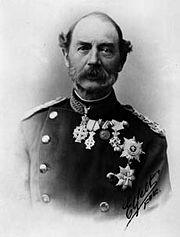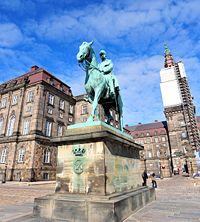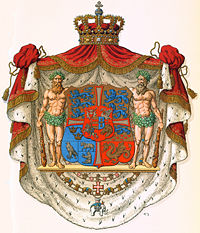Christian IX of Denmark
| Christian IX | |
|---|---|
| King of Denmark (more...) | |
 |
|
| King of Denmark (more...) | |
| Reign | November 15 1863-January 29 1906 |
| Predecessor | Frederick VII |
| Successor | Frederick VIII |
| Consort | Louise of Hesse-Kassel |
| Issue | |
| Frederick VIII Alexandra, Queen of the United Kingdom George I of Greece Dagmar, Empress of Russia Thyra, Crown Princess of Hanover Prince Valdemar |
|
| Royal house | House of Schleswig-Holstein-Sonderburg-Glücksburg |
| Royal motto | With God for honour and justice |
| Father | Friedrich Wilhelm, Duke of Schleswig-Holstein-Sonderburg-Glücksburg |
| Mother | Louise Caroline of Hesse-Kassel |
| Born | April 8, 1818 Gottorp, Schleswig, Duchy of Schleswig |
| Died | January 29, 1906 (aged 87) |
| Burial | Roskilde Cathedral |
Christian IX (8 April, 1818 - 29 January, 1906) was King of Denmark from November 16, 1863 to January 29, 1906.
Contents |
Early life
He was born in Gottorp, the fourth son of Friedrich Wilhelm, Duke of Schleswig-Holstein-Sonderburg-Glücksburg and Louise Caroline, Princess of Hesse. Through his mother, Christian was a great-grandson of Frederick V of Denmark, great-great-grandson of George II of Great Britain and descendant of several other monarchs, but had no direct claim to any European throne.
Through his father, Christian was a member of a junior male branch of the House of Oldenburg and a prince of the Schleswig-Holstein-Sonderburg-Glücksburg line, a junior branch of the family which had ruled Denmark for centuries (he was a direct male-line descendant of King Christian III of Denmark) and was (albeit a junior) agnatic descendant of Helwig of Schauenburg (countess of Oldenburg), mother of King Christian I of Denmark, who was the "Semi-Salic" heiress of her brother Adolf of Schauenburg, last Schauenburg duke of Schleswig and count of Holstein. As such, Christian was eligible to succeed in the twin duchies of Schleswig-Holstein, but not first in the line.
He grew up in Denmark and was educated in the Military Academy of Copenhagen.
As a young man, he unsuccessfully sought the hand of his third cousin Queen Victoria in marriage. At the Amalienborg Palace in Copenhagen on 26 May, 1842, he married Louise of Hesse-Kassel (or Hesse-Cassel), a niece of Christian VIII.
In 1847, under the blessing from the great powers of Europe, he was chosen as heir presumptive after the extinction of the most senior line to the Danish throne by Christian VIII, as the future Frederick VII seemed incapable of fathering children. A justification for this choice of heir was Christian's wife Louise of Hesse-Kassel. (She was, as a great-niece of Christian VII, a closer heir to the throne than her husband.)
Christian succeeded upon his death Frederick VII to the throne on November 15, 1863. Denmark was immediately plunged into a crisis over the possession and status of Schleswig and Holstein, two provinces to Denmark's south. Under pressure, Christian signed the November Constitution, a treaty that made Schleswig part of Denmark. This resulted in a brief war between Denmark and a Prussian/Austrian alliance in 1864. This Second war of Schleswig's outcome was unfavorable to Denmark and led to the incorporation of Schleswig into Prussia in 1865. Holstein was likewise incorporated into Prussia in 1865, following further conflict between Austria and Prussia.
How Christian became the heir

Frederick's childlessness had presented a thorny dilemma and the question of succession to the Danish throne proved problematic. Denmark's adherence to the Salic Law and a burgeoning nationalism within the German-speaking parts of Schleswig-Holstein hindered all hopes of a peaceful solution. Proposed resolutions to keep the two Duchies together and as a part of Denmark proved unsatisfactory to both Danish and German interests. While Denmark had adopted the Salic Law, this only affected the descendants of Frederick III of Denmark (who was the first hereditary monarch of Denmark - before him the kingdom was officially elective). Agnatic descent from Frederick III ended when Frederick VII died. At that point, the law of succession promulgated by Frederick III provided for a Semi-Salic succession. There were however several ways to interpret to whom the crown could pass, since the provision was not entirely clear as to whether a claimant to the throne could be the closest female relative or not.
|
|||||||||||||||||||||||||||||||||||||||||
As the nations of Europe looked on, the numerous descendants of Helwig of Schauenburg began to vie for the Danish throne. Frederick VII belonged to the senior branch of Helwig's descendants. In 1863, Frederick, Duke of Schleswig-Holstein-Sonderburg-Augustenburg (1829-1880) (the future father-in-law of Kaiser Wilhelm II of Germany), proclaimed himself Frederick VIII of Schleswig-Holstein. Frederick von Augustenburg became the symbol of the nationalist German independence-movement in Schleswig-Holstein, after his father (in exchange for money) renounced his claims as first in line to inherit the twin-duchies of Schleswig and Holstein. Following the London protocol of May 8, 1852, which concluded the First war of Schleswig and given his father's renunciation, Frederick was deemed ineligible to inherit.
The closest female relatives of Frederick VII were the children of his paternal aunt, Louise, who had married a scion of the cadet branch of the House of Hesse. However, they were not agnatic descendants of the royal family and thus not eligible to succeed in Schleswig-Holstein.
The dynastic female heiress reckoned according to the original law of primogeniture of Frederick III was Caroline of Denmark (1793-1881), the childless eldest daughter of the late king Frederick VI. Along with another childless daughter Wilhelmine of Denmark (1808-1891), Duchess of Glucksburg, and sister-in-law of Christian IX, the next heir was Louise, sister of Frederick VI, who had married the Duke of Augustenburg. The chief heir to that line was the selfsame Frederick of Augustenborg, but his turn would have come only after the death of two childless princesses who were very much alive in 1863.
The House of Glucksburg also held a significant interest in the succession to the throne. A more junior branch of the royal clan, they were also heirs of Frederick III, through the daughter of King Frederick V of Denmark. Lastly, there was yet a more junior agnatic branch that was eligible to succeed in Schleswig- Holstein. There was Christian himself and his three older brothers, the eldest of whom, Karl, was childless, but the others had produced children, and male children at that.
Prince Christian had been a foster "grandson" of the childless royal couple Frederick VI and his queen consort Marie (Marie Sophie Frederikke of Hesse). Familiar with the royal court and the traditions of the recent monarchs, their young ward, Prince Christian was great-nephew of queen Marie, and descendant of a first cousin of Frederick VI. He was brought up as Danish, having lived in Danish-speaking lands of the royal dynasty, and had not become a German nationalist which made him a relatively good candidate from the Danish point of view. As junior agnatic descendant, he was eligible to inherit Schleswig-Holstein, but was not the first in line. As descendant of Frederick III, he was eligible to succeed in Denmark, although here too, he was not first in line.
In 1842, Christian married Princess Louise of Hesse, eldest daughter of the eldest son of the closest female relative of Frederick VII. Louise's father and brothers, princes of Hesse, renounced their rights in favor of Louise and her husband. Prince Christian's wife was now the closest female heiress of Frederick VII.
In 1852, the thorny question of Denmark's succession was resolved by legislation through which Christian was chosen to succeed Frederick VII as the country's next reigning monarch.
Christian IX was the 1,007th Knight of the Order of the Golden Fleece in Spain in 1864 and the 744th Knight of the Order of the Garter in 1865.
King

When Frederick died in 1863, Christian assumed the throne as Christian IX.
In November 1863 Frederick of Augustenburg claimed the twin-duchies in succession after King Frederick VII of Denmark, who also was the Duke of Schleswig and Holstein, and who had died without a male heir.
In 1864, Prussia and Austria initiated the Second war of Schleswig which eventually led to the Danish loss of both South Jutland and Holstein.
Europe's "Father in Law"
Christian and Louise gave birth to six remarkably successful children:
- Crown Prince Frederick of Denmark, later Frederick VIII of Denmark (June 3, 1843 - May 14, 1912). Married Princess Lovisa of Sweden.
- Princess Alexandra of Denmark, later the Queen consort of Edward VII of the United Kingdom (December 1, 1844 - November 20, 1925).
- Prince Vilhelm (December 24, 1845 - March 18, 1913), later King George I of Greece. Married Olga Konstantinova, Grand Duchess of Russia.
- Princess Dagmar of Denmark, later the consort of Tsar Alexander III of Russia (November 26, 1847 - October 13, 1928).
- Princess Thyra of Denmark, later consort of Ernst August of Hanover, 3rd Duke of Cumberland (September 29, 1853 - February 26, 1933).
- Prince Valdemar of Denmark, (October 27, 1858 - January 14, 1939). Married Princess Marie de Orleáns-Bourbon (1865-1909).
Four of his children became monarchs, sitting on the thrones (either directly or as a consort) of Denmark, Great Britain, Russia and Greece. A fifth, daughter Thyra, would have become Queen of Hanover, had her husband's throne not been abolished before his reign began. The great dynastical success of the six children was to a great extent not the favor of Christian IX himself, but due to Christian's wife Louise of Hesse-Kassel dynastical ambitions. Some have compared her dynastical capabilities with those of Queen Victoria of the United Kingdom.
Christian's grandsons included Nicholas II of Russia, Constantine I of Greece, George V of the United Kingdom, Christian X of Denmark and Haakon VII of Norway. He was, in the last years of his life, named Europe's "father-in-law". Today, most of Europe's reigning and ex-reigning royal families are direct descendants of Christian IX.
There is a story that, while on an outing with his children and their families, they happened across a lost man whom they helped to find his way. Upon reaching the road, the man inquired as to the identities of Christian and his family. Christian replied truthfully, stating the names and titles of all present. Not believing Christian but instead taking it in humour, he proclaimed himself to be Jesus Christ before departing.
Christian died peacefully of old age at 87 at the Amalienborg Palace in Copenhagen and was buried in Roskilde Cathedral.
Politics
| Monarchical styles of King Christian IX of Denmark |
|
 |
|
| Reference style | His Majesty |
|---|---|
| Spoken style | Your Majesty |
| Alternative style | Sire |
The defeat of 1864 cast a shadow of Christian IX's rule for many years also because his attitude to the Danish case -- probably without reason -- was claimed to be half-hearted. This unpopularity was worsened, as he sought, unsuccessfully, to prevent the spread of democracy throughout Denmark by supporting the authoritarian and conservative prime minister Estrup whose rule 1875-94 was by many seen as a semi-dictatorship. However, he signed a treaty in 1874 which allowed Iceland, then a Danish possession, to have its own constitution, albeit one that still had Denmark ruling Iceland. In 1901 he reluctantly asked Johan Henrik Deuntzer to form a government and this resulted in the formation of the Cabinet of Deuntzer. The cabinet consisted of members of the Venstre Reform Party and was the first Danish government not to include the conservative party Højre, even though Højre never had a majority of the seats in the Folketing. This was the beginning of the Danish tradition of parliamentarism and clearly bettered his reputation for his last years.
Another reform occurred in 1866, when the Danish constitution was revised so that Denmark's upper chamber would have more power than the lower. Social security also took a few steps forward during his reign. Old age pensions were introduced in 1891 and unemployment and family benefits were introduced in 1892.
Titles from birth to death
- His Serene Highness Prince Christian of Schleswig-Holstein-Sonderburg-Beck
- His Serene Highness Prince Christian of Schleswig-Holstein-Sonderburg-Glücksburg
- His Royal Highness Prince Christian of Denmark
- His Majesty Christian IX of Denmark
Ancestry
| Ancestors of Christian IX of Denmark | ||||||||||||||||||||||||||||||||||||||||||||||||||||||||||||||||||||||||||||||||||||||||||||||||||||||||||||||||||||||||||||||||||||||||||||||||||||||||||||||||||||||||||||||||||||||||||||||||||||||||||||||||||||||||||||||||||||||||||||||||||||||||||||||||||||||||||||||||||||||||||||||||||||||||||||||||||||||||||||||||||||||||||||||||||||||||||||||||||||||||||||||||||||||||||||||||||||||||||||||||||||||||||||||||||||||||||||||||||||||||||||||||||||||||||||||||||||||||||||||||||||||||||||||||||||||||||||||||||||||||||||||||||||||||||||||||||
|---|---|---|---|---|---|---|---|---|---|---|---|---|---|---|---|---|---|---|---|---|---|---|---|---|---|---|---|---|---|---|---|---|---|---|---|---|---|---|---|---|---|---|---|---|---|---|---|---|---|---|---|---|---|---|---|---|---|---|---|---|---|---|---|---|---|---|---|---|---|---|---|---|---|---|---|---|---|---|---|---|---|---|---|---|---|---|---|---|---|---|---|---|---|---|---|---|---|---|---|---|---|---|---|---|---|---|---|---|---|---|---|---|---|---|---|---|---|---|---|---|---|---|---|---|---|---|---|---|---|---|---|---|---|---|---|---|---|---|---|---|---|---|---|---|---|---|---|---|---|---|---|---|---|---|---|---|---|---|---|---|---|---|---|---|---|---|---|---|---|---|---|---|---|---|---|---|---|---|---|---|---|---|---|---|---|---|---|---|---|---|---|---|---|---|---|---|---|---|---|---|---|---|---|---|---|---|---|---|---|---|---|---|---|---|---|---|---|---|---|---|---|---|---|---|---|---|---|---|---|---|---|---|---|---|---|---|---|---|---|---|---|---|---|---|---|---|---|---|---|---|---|---|---|---|---|---|---|---|---|---|---|---|---|---|---|---|---|---|---|---|---|---|---|---|---|---|---|---|---|---|---|---|---|---|---|---|---|---|---|---|---|---|---|---|---|---|---|---|---|---|---|---|---|---|---|---|---|---|---|---|---|---|---|---|---|---|---|---|---|---|---|---|---|---|---|---|---|---|---|---|---|---|---|---|---|---|---|---|---|---|---|---|---|---|---|---|---|---|---|---|---|---|---|---|---|---|---|---|---|---|---|---|---|---|---|---|---|---|---|---|---|---|---|---|---|---|---|---|---|---|---|---|---|---|---|---|---|---|---|---|---|---|---|---|---|---|---|---|---|---|---|---|---|---|---|---|---|---|---|---|---|---|---|---|---|---|---|---|---|---|---|---|---|---|---|---|---|---|---|---|---|---|---|---|---|---|---|---|---|---|---|---|---|---|---|---|---|---|---|---|---|---|---|---|---|---|---|---|---|---|---|---|---|---|---|---|---|---|---|---|---|---|---|---|---|---|---|---|---|---|---|---|---|---|---|---|---|---|---|---|---|---|---|---|---|---|---|---|---|---|---|---|---|---|---|---|---|---|---|---|---|---|---|---|---|---|---|---|---|---|---|---|---|---|---|---|---|---|---|---|---|---|---|---|---|---|---|---|---|---|---|---|---|---|---|---|
|
||||||||||||||||||||||||||||||||||||||||||||||||||||||||||||||||||||||||||||||||||||||||||||||||||||||||||||||||||||||||||||||||||||||||||||||||||||||||||||||||||||||||||||||||||||||||||||||||||||||||||||||||||||||||||||||||||||||||||||||||||||||||||||||||||||||||||||||||||||||||||||||||||||||||||||||||||||||||||||||||||||||||||||||||||||||||||||||||||||||||||||||||||||||||||||||||||||||||||||||||||||||||||||||||||||||||||||||||||||||||||||||||||||||||||||||||||||||||||||||||||||||||||||||||||||||||||||||||||||||||||||||||||||||||||||||||||
See also
- Danish royal family tree
External links
- Royal House of Denmark
- Ducal House of Schleswig-Holstein-Sonderburg-Glücksburg
- Landgravial House of Hesse-Kassel
- The Danish Monarchy's official site
- A detailed listing of his descendants
- An ancestor chart of him ; not necessarily reliable
|
Christian IX
House of Schleswig-Holstein-Sonderburg-Glücksburg
Cadet branch of the House of Oldenburg
Born: April 8 1818 Died: January 29 1906 |
||
| Regnal titles | ||
|---|---|---|
| Preceded by Frederick VII |
King of Denmark 1863-1906 |
Succeeded by Frederick VIII |
|
|||||||||||||||||
| Persondata | |
|---|---|
| NAME | Christian IX of Denmark |
| ALTERNATIVE NAMES | |
| SHORT DESCRIPTION | Danish monarch |
| DATE OF BIRTH | April 8, 1818 |
| PLACE OF BIRTH | Gottorp, Schleswig, Schleswig-Holstein |
| DATE OF DEATH | January 29, 1906 |
| PLACE OF DEATH | ? |